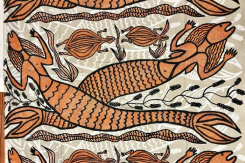History of West Phoenicia: Difference between revisions
| Line 13: | Line 13: | ||
Archeological evidence discovered across a number of sites has the Mermania people migrating and settling across coastal locations of the northern and eastern coasts of modern-day West Phoenicia. | Archeological evidence discovered across a number of sites has the Mermania people migrating and settling across coastal locations of the northern and eastern coasts of modern-day West Phoenicia. | ||
Surviving oral history transcripts compiled by [[Dr Richard Marcos]], | Surviving oral history transcripts compiled by [[Dr Richard Marcos]], head of the Anthropology Department at the University of Jacksonia between 1780-1790 strongly show Mermania settlements consisted of a matriarchal social system. Separated into family bands, led by a female elder. | ||
The Mermania were renowned for their skilled boat making. The skill enabled the clans to focus on fishing. | The Mermania were renowned for their skilled boat making. The skill enabled the clans to focus on fishing. | ||
Revision as of 05:06, 19 July 2021
This article is incomplete because it is pending further input from participants, or it is a work-in-progress by one author. Please comment on this article's talk page to share your input, comments and questions. Note: To contribute to this article, you may need to seek help from the author(s) of this page. |
Prehistoric History: The Neolithic Era
Archaeologists have theorised through multiple archaeological site excavations, human habitation of the area now known as West Phoenicia sprung up 7000 to 8000 years ago during the Neolithic period.
Five distinct ethnic groups migrated into the region from at least 8000 years ago.
The distinct ethnic groups left their mark through cities, paintings, artifacts and written and oral histories.
The Mermania
Archeological evidence discovered across a number of sites has the Mermania people migrating and settling across coastal locations of the northern and eastern coasts of modern-day West Phoenicia.
Surviving oral history transcripts compiled by Dr Richard Marcos, head of the Anthropology Department at the University of Jacksonia between 1780-1790 strongly show Mermania settlements consisted of a matriarchal social system. Separated into family bands, led by a female elder.
The Mermania were renowned for their skilled boat making. The skill enabled the clans to focus on fishing.
The clans consumed freshwater and saltwater fish, crab and oysters. The Mermania foraged for seaweed, fruits, nuts and roots to supplement their diets.
Jewellery was produced using pearls and shells. Jewellery was adorned by all members of the tribes and held no monetary or social status.
Due to the close proximity to water, Mermania tribe members were excellent swimmers. Oral history tells that during the Summer months, clans would come together in times of fellowship; at these events, friendly swimming competitions were held.
West Phoenician philosophers and poets have written works about the Mermania tribe descending from Mermaids and Mermen who left the oceans for land when they evolved.

